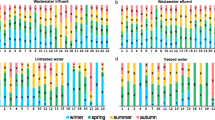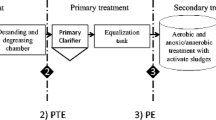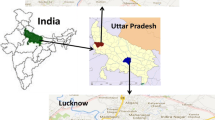Abstract
Research on the effects of chemical pollution in the environment that is related to urban wastewaters’ discharge and reuse until recently was focused almost exclusively on conventional pollutants. During the last several years though there has been a growing level of concern related to the hypothesis that various chemicals may exhibit endocrine disrupting effects. In addition, thousands of tons of pharmacologically active substances are used annually ending up in the wastewaters. In many countries facing prolonged droughts and implementing wastewater reuse schemes for irrigation and groundwater discharge, the existence of xenobiotic compounds in the tertiary treated wastewaters constitutes a new concern. This study describes the application of a recently developed multi-residue method for the determination of 29 multi-class pharmaceuticals using off line solid phase extraction followed by liquid chromatography–triple quadrupole mass spectrometry (LC–MS–MS). The method was applied for the analysis of pharmaceutical residues at three sewage treatment plants in Cyprus serving major coastal Mediterranean cities. The presence of 19 pharmaceuticals was confirmed. For some of the compounds high concentrations were obtained for the final effluents (e.g. ofloxacin: 4.82 μg/L, diclofenac: 5.51 μg/L, carbamazepine: 27.27 μg/L, metoprolol: 9.59 μg/L). Concerning the elimination potential, what was derived from the study is that the biological treatment step contributes the most to the removal of the compounds while sand filtration and chlorination steps reduce slightly the residual concentrations.
Similar content being viewed by others
References
Al-Rifai J, Gabelish C, Schäfer A (2007) Occurrence of pharmaceutically active and non-steroidal estrogenic compounds in three different wastewater recycling schemes in Australia. Chemosphere 69:803–815
Buser HR, Poiger T, Müller MD (1999) Occurrence and environmental behavior of the chiral pharmaceutical drug ibuprofen in surface waters and in wastewater. Environ Sci Technol 33:2529–2535
Castiglioni S, Bagnati R, Fanelli R, Pomati F, Calamari D, Zuccat E (2006) Removal of pharmaceuticals in sewage treatment plants in Italy. Environ Sci Technol 40(1):357–363
Chelliapan S, Wilby T, Sallis PJ (2006) Performance of an up-flow anaerobic stage reactor (UASR) in the treatment of pharmaceutical wastewater containing macrolide antibiotics. Water Res 40:507–516
Clara M, Kreuzinger N, Strenn B, Gans O, Kroiss H (2005) The solids retention time-suitable design parameter to evaluate the capacity of wastewater treatment plants to remove micropollutants. Water Res 39(1):97–106
Golet EM, Xifra I, Siegrist H, Alder AC, Giger W (2003) Environmental exposure assessment of fluoroquinolone antibacterial agents from sewage to soil. Environ Sci Technol 37(15):3243–3249
Gómez MJ, Martínez Bueno MJ, Lacorte S, Fernández-Alba AR, Agüera A (2007) Pilot survey monitoring pharmaceuticals and related compounds in a sewage treatment plant located on the Mediterranean coast. Chemosphere 66:993–1002
Gros M, Petrovic M, Barceló D (2006) Development of a multi-residue analytical methodology based on liquid chromatography–tandem mass spectrometry (LC–MS/MS) for screening and trace level determination of pharmaceuticals in surface and wastewaters. Talanta 70:678–690
Joss A, Zabczynski S, Göbel A, Hoffmann B, Löffler D, McArdell CS, Ternes TA, Thomsen A, Siegrist H (2006) Biological degradation of pharmaceuticals in municipal wastewater treatment: proposing a classification scheme. Water Res 40(8):1686–1696
Koutsouba V, Heberer Th, Fuhrmann B, Schmidt-Baumler K, Tsipi D, Hiskia A (2003) Determination of polar pharmaceuticals in sewage water of Greece by gas chromatography-mass spectrometry. Chemosphere 51(2):69–75
Kreuzinger N, Clara M, Strenn B, Kroiss H (2004) Relevance of the sludge retention time (SRT) as design criteria for wastewater treatment plants for the removal of endocrine disruptors and pharmaceuticals from wastewater. Water Sci Technol 50(5):149–156
Lindberg RH, Olofsson UL, Rendahl P, Johansson MI, Tysklind M, Andersson BAV (2006) Behavior of fluoroquinolones and trimethoprim during mechanical, chemical, and active sludge treatment of sewage water and digestion of sludge. Environ Sci Technol 40(3):1042–1048
Peng X, Wang Z, Kuang W, Tan J, Li K (2006) A preliminary study on the occurrence and behavior of sulfonamides, oflyoxacin and chloramphenicol antimicrobials in wastewaters of two sewage treatment plants in Guangzhou, China. Sci Total Environ 371:314–322
Radjenovic J, Petrovic M, Barceló D (2007) Analysis of pharmaceuticals in wastewater and removal using a membrane bioreactor. Anal Bioanal Chem 387:1365–1377
Radjenovic J, Petrovic M, Barcelo D (2009) Fate and distribution of pharmaceuticals in wastewater and sewage sludge of the conventional activated sludge (CAS) and advanced membrane bioreactor (MBR) treatment. Water Res 43(3):831–841
Reif R, Suárez S, Omil F, Lema JM (2008) Fate of pharmaceuticals and cosmetic ingredients during the operation of a MBR treating sewage. Desalination 221:511–517
Santos JL, Aparicio I, Alonso E (2007) Occurrence and risk assessment of pharmaceutically active compounds in wastewater treatment plants. A case study: Seville city (Spain). Environ Int 33:596–601
Stumpf M, Ternes TA, Wilken RD, Rodrigues SV, Baumann W (1999) Polar drug residues in sewage and natural waters in the state of Rio de Janeiro, Brazil. Sci Total Environ 225:135–141
Tangsubkul N, Beavis P, Moore SI, Lundie S, Waite TD (2005) Life cycle assessment of water recycling technology. Water Resour Manage 19:521–537
Tauxe-Würsch A, De Alencastro LF, Grandjean D, Tarradellas J (2005) Occurrence of several acidic drugs in sewage treatment plants in Switzerland and risk assessment. Water Res 39(9):1761–1772
Tixier C, Singer HP, Ollers S, Muller SR (2003) Occurrence and fate of carbamazepine, clofibric acid, diclofenac, ibuprofen, ketoprofen, and naproxen in surface waters. Environ Sci Technol 37:1061–1068
Vieno N, Tuhkanen T, Kronberg L (2007) Elimination of pharmaceuticals in sewage treatment plants in Finland. Water Res 41:1001–1012
Author information
Authors and Affiliations
Corresponding author
Rights and permissions
About this article
Cite this article
Fatta-Kassinos, D., Hapeshi, E., Achilleos, A. et al. Existence of Pharmaceutical Compounds in Tertiary Treated Urban Wastewater that is Utilized for Reuse Applications. Water Resour Manage 25, 1183–1193 (2011). https://doi.org/10.1007/s11269-010-9646-4
Received:
Accepted:
Published:
Issue Date:
DOI: https://doi.org/10.1007/s11269-010-9646-4




